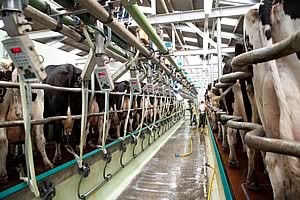2011-02-14
A new set of targets for UK dairy herd performance is now available for producers and advisers thanks to a study published by the University of Reading.
The study, ‘Key performance indicators for the UK dairy herd’ uses milk recording data from a cross section of 500 commercial dairy herds. The herds were selected at random from black and white herds who calve year round and carry out monthly recording with NMR. The study looks at the variation in herd performance for 25 parameters, covering production, fertility and health.
The study presents the variation in performance for each parameter and gives the level achieved by the ‘best’ 25% of herds as a realistic and achievable target. It also shows the performance level achieved by the ‘worst’ 25%. For example, while 25% of herds achieve somatic cell counts of 169,000 cells/ml or better, there are 25% of herds recording 268,000 cells/ml or worse.
Data from the study is used directly by NMR’s InterHerd+ dairy management program. Through this program, producers, their vets and advisers can benchmark the individual herd’s performance for each parameter against those of the 500 study herds. The strengths and weaknesses of the herd can then be clearly identified.
“All herds have a range in performance with some high cell count cows, and some cows that take longer to conceive,” says James Hanks from the University’s Veterinary Epidemiology & Economics Research Unit (VEERU) and joint author of the study. “The key is to know at what level this becomes a cause for concern. Data from this study can provide the answers and give a great reference point for producers and advisers.”
The ‘Key performance indicators for the UK dairy herd’ report uses a much larger and more representative sample of dairy herds than has been possible in the past. “The herds are a true cross-section of commercial dairy herds which makes the data directly relevant to all dairy producers and of great benefit to the UK dairy industry,” adds Dr Hanks.
“We plan to repeat this study annually. It will continue the University of Reading’s strong tradition in livestock information from Dick Esslemont’s DAISY reports through to the University’s close association with InterHerd and Herd Companion.”
The University of Reading report ‘Key performance indicators for the UK dairy herd’ was written by Dr James Hanks and Dr Mohamad Kossaibati and can be downloaded from www.veeru.rdg.ac.uk/section1/Research.htm or www.nmr.co.uk
 Cogent Breeding Bolsters its Jersey Expertise Cogent Breeding Bolsters its Jersey Expertise
 No. 1 PLI and No.1 Type Jersey Sires Now Available Sexed No. 1 PLI and No.1 Type Jersey Sires Now Available Sexed
 Holstein Bulls Sell to 4,000gns at Moira Holstein Bulls Sell to 4,000gns at Moira

|




